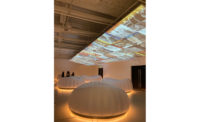In these times of uncertainty and change, the need for universities—as enclaves of students, staff, researchers and teachers—to plan for natural or man-made disruptions has never been greater. In response, forward-thinking planners and facility managers are combining mature design ideas with new technologies to make their institutions more resilient and supportive of their constituents and surrounding communities.
“Resilience” is the capacity to adapt to changing conditions and maintain or regain functionality and vitality in the face of stress or disturbance. Many think of resilience as the capacity to bounce back from disruptions. Resilient design combines sustainable design strategies with physical security improvements. It mixes infrastructure upgrades and energy efficiency projects, and combines place-making and disaster preparedness projects.
It’s a design paradigm that takes many “old ideas” in design and enlivens them with a renewed purpose. For example, some of the resilient design strategies campus planners and facility managers have implemented include microgrids, on-site power generation and energy, water and thermal storage.
Microgrids, such as one at the University of Texas, enable demand-response energy management, which lets providers power equipment up or down in times of need or saves money by using off-peak power. But microgrids also can be designed to let universities “island” from the power grid during an outage and operate independently if they have their own on-site generation or energy, water or thermal storage.
Universities typically invest in thermal or energy storage to provide operational cost savings, but it also doubles as back-up resources during a crisis. The University of Arizona has one of the largest ice storage installations in the world, saving the university $38,000 per month, while the University of Cincinnati stores 4 million gallons of chilled water under its football practice field. Such strategies help the day-to-day efficiency of the campuses, but also add resiliency in times of wider outages by providing a local source of cooling energy the campuses can tap.
A resilient campus combines local energy sources, with a smart microgrid, and then adds to that high-performance buildings, which are extremely energy- and water-efficient compared to building code. It times of grid outages, efficient buildings require less stored power or generators to maintain function.
Other mature ideas help create resilient people and communities, including good place making.Good place-making is a concept in planning and design where one creates a space where people want to be; where people feel comfortable; where they choose to gather together, or find peace and quiet…whatever function the space or place is designed to provide for the people who will inhabit it.
Good “place-making” is an important part of the art of good design. A lack of good place-making leads to public spaces or buildings that feel sterile and unwelcoming. Before, during and after a disruption people need to connect with classmates and colleagues to offer mutual support and find services. By implementing good place-making before a shock, those community hubs already exist in the fabric of a campus. A campus is only as resilient as its residents.
By investing in the safety and security that comes from good place-making and resilient design, universities become lifeboats not only for themselves but for the neighboring communities. Such was the case at Princeton University in 2012. The New Jersey institution had combined its green building efforts with a hybrid microgrid, on-campus co-generation and excellent place-making.
Then Hurricane Sandy hit, killing 147 people, leaving thousands homeless and millions without power. Princeton was able to island itself from the downed power grid and operate its central plant independently. The university quickly became a refuge not only for its students and faculty, but for area residents as well. Seeing the lights on at the University while the surrounding city was in the dark, citizens from nearby communities came to warm up, charge cell phones, find shelter and protection, and connect with emergency responders.
For colleges and universities, which continue to reinvest and reinvent themselves over decades and even centuries, resilient design provides a prescient strategy that wins respect and appreciation not only from administrators, parents, alumni and board members, but from the society within which they are embedded as well.
Embracing resilience is a smart strategy worthy of institutions of higher learning.
Nadja Turek, PE, LEED AP BD+C, GGP, is an engineer and sustainable design expert within Woolpert Inc.’s Research and Development group. Mrs. Turek is responsible for guiding Woolpert’s sustainability program and identifying and implementing new technical solutions and capabilities.






Post a comment to this article
Report Abusive Comment